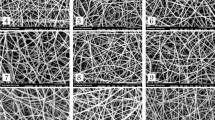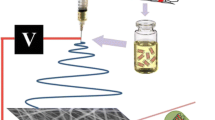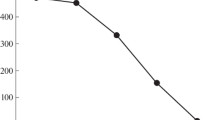Abstract
Nanofibers prepared by the electrospinning process are good candidates for the local delivery of anticancer drugs. In the present study, 5-Fluorouracil (5-FU) and Paclitaxel (Taxol) anticancer drugs were loaded into the mono and tri-layered polycaprolactone (PCL)/gelatin (Gel) electrospun nanofibers. The performance of nanofibers was investigated for the controlled release of anticancer drugs against MCF-7 breast cancer cell death. The drug loading efficiency of Taxol and 5-FU from tri-layered nanofiber samples (PCL/Gel–PCL/Taxol /Gel/5-FU–PCL/Gel nanofibers) was 97 and 98%, respectively. These amounts for mono-layered nanofibers (PCL/Taxol and Gel/5-FU nanofibers) were 85 and 87% for Taxol and 5-FU, respectively. The controlled release of anti-cancer drugs from mono- and tri-layered nanofibers containing 1.5 mg Taxol and 1.5 mg 5-FU was obtained within 36 and 72 h, respectively. By increasing the content of Taxol and 5-FU to 3.0 mg in tri-layered nanofibers, the controlled release time was decreased to 60 h. 5-FU and Taxol release data were best described using the Korsmeyer–peppas model pharmacokinetic model. More than 98% of L929 fibroblast cells survived in the presence of the PCL/Gel nanofibers, which indicated good biocompatibility of the nanofibers. The maximum cytotoxicity of tri-layered PCL/Taxol /Gel/5-FU nanofibers containing 3 mg 5-FU and 3 mg Taxol was 75 ± 3% against MCF-7 breast cancer cells after 72 h. The results showed that tri-layered nanofibers are a more efficient carrier for drug loading and treatment of MCF-7 breast cancer cells than mono-layered nanofibers.







Similar content being viewed by others
References
Peng CL, Lai PS, Lin FH, Wu SY, Shieh MJ (2009) Dual chemotherapy and photodynamic therapy in an HT-29 human colon cancer xenograft model using SN-38-loaded chlorin-core star block copolymer micelles. Biomaterials 30:3614–3625
Wei L, Cai C, Lin J, Chen T (2009) Dual-drug delivery system based on hydrogel/micelle composites. Biomaterials 30:2606–2613
Sipos B, Budai-Szűcs M, Kókai D, Orosz L, Burián K, Csorba A, Nagy ZZ, Balogh GT, Csóka I, Katona G (2022) Erythromycin-loaded polymeric micelles: in situ gel development, in vitro and ex vivo ocular investigations. Europ J Pharm Biopharm 180:81–90. https://doi.org/10.1016/j.ejpb.2022.09.023
Kang R, Song M, Fang Z, Liu K (2022) Nano-composite hydrogels of Cu-Apa micelles for anti-vasculogenic mimicry. J Drug Target 19:1–3. https://doi.org/10.1080/1061186X.2022.2115047
Konishi M, Tabata Y, Kariya M, Hosseinkhani H, Suzuki A, Fukuhara K, Mandai M, Takakura K, Fujii S (2005) In vivo anti-tumor effect of dual release of cisplatin and adriamycin from biodegradable gelatin hydrogel. J Control Release 103:7–19
Norouzi M, Nazari B, Miller DW (2016) Injectable hydrogel-based drug delivery systems for local cancer therapy. Drug Discovery Today 21:1835–1849
Pakian S, Radmanesh F, Sadeghi-Abandansari H, Nabid MR (2022) Gelatin-based Injectable hydrogel/microgel composite as a combinational dual drug delivery system for local co-delivery of curcumin and 5-fluorouracil in synergistic therapy of colorectal cancer. ACS Appl Polym Mater 4:8238–8252
Chen X, Zhu Q, Liu Z, Zhang T, Gong C, Li J, Yan H, Lin Q (2023) Self-aggregate performance of hexyl alginate ester derivative synthesized via SN2 reaction for controlled release of λ-cyhalothrin. Polym Bull 80:495–514
Men W, Zhu P, Dong S, Liu W, Zhou K, Bai Y, Liu X, Gong S, Zhang S (2020) Layer-by-layer pH-sensitive nanoparticles for drug delivery and controlled release with improved therapeutic efficacy in vivo. Drug Deliv 27:180–190. https://doi.org/10.1080/10717544.2019.1709922
Tabakoglu S, Kołbuk D, Sajkiewicz P (2023) Multifluid electrospinning for multi-drug delivery systems: pros and cons, challenges, and future directions. Biomater Sci 11:37–61
Immich AP, Arias ML, Carreras N, Boemo RL, Tornero JA (2013) Drug delivery systems using sandwich configurations of electrospun poly (lactic acid) nanofiber membranes and ibuprofen. Mater Sci Eng C 33:4002–4008
Okuda T, Tominaga K, Kidoaki S (2010) Time-programmed dual release formulation by multilayered drug-loaded nanofiber meshes. J Control Release 143:258–264
Robles-Martinez P, Xu X, Trenfield SJ, Awad A, Goyanes A, Telford R, Basit AW, Gaisford S (2019) 3D printing of a multi-layered polypill containing six drugs using a novel stereolithographic method. Pharmaceutics 11:274. https://doi.org/10.3390/pharmaceutics11060274
Castellano JM, Sanz G, Peñalvo JL, Bansilal S, Fernández-Ortiz A, Alvarez L, Guzmán L, Linares JC, García F, D’Aniello F, Arnáiz JA (2014) A polypill strategy to improve adherence: results from the FOCUS project. J Am Coll Cardiol 64:2071–2082
Pereira BC, Isreb A, Forbes RT, Dores F, Habashy R, Petit J-B, Alhnan MA, Oga EF (2019) Temporary plasticiser’: a novel solution to fabricate 3D printed patient-centred cardiovascular ‘polypill’ architectures. Eur J Pharm Biopharm 135:94–103
Sadia M, Isreb A, Abbadi I, Isreb M, Aziz D, Selo A, Timmins P, Alhnan MA (2018) From ‘fixed dose combinations’ to ‘a dynamic dose combiner’: 3D printed bi-layer antihypertensive tablets. Eur J Pharm Sci 123:484–494
Mašek J, Lubasova D, Lukáč R, Turanek-Knotigova P, Kulich P, Plockova J, Mašková E, Prochazka L, Koudelka Å, Sasithorn N, Gombos J (2017) Multi-layered nanofibrous mucoadhesive films for buccal and sublingual administration of drug-delivery and vaccination nanoparticles-important step towards effective mucosal vaccines. J Control Release 249:183–195. https://doi.org/10.1016/j.jconrel.2016.07.036
Panigrahi G, Medhi H, Wasnik K, Patra S, Gupta P, Pareek D, Maity S, Mandey M, Paik P (2022) Hollow mesoporous SiO2–ZnO nanocapsules and effective in vitro delivery of anticancer drugs against different cancers with low doses of drugs. Mater Chem Phys 287:126287. https://doi.org/10.1016/j.matchemphys.2022.126287
Trushina DB, Sapach AY, Burachevskaia OA, Medvedev PV, Khmelenin DN, Borodina TN, Soldatov MA, Butova VV (2022) Doxorubicin-loaded core–shell UiO-66@ SiO2 metal–organic frameworks for targeted cellular uptake and cancer treatment. Pharmaceutics 14:1325. https://doi.org/10.3390/pharmaceutics14071325
Kazmi I, Al-Abbasi Fahad A, Imam Syed Sarim, Afzal Muhammad, Nadeem Muhammad Shahid, Altayb Hisham N, Alshehri Sultan (2022) Formulation of piperine nanoparticles: in vitro breast cancer cell line and in vivo evaluation. Polymers 14(7):1349. https://doi.org/10.3390/polym14071349
Sabzini M, Pourmadadi M, Yazdian F, Khadiv-Parsi P, Rashedi H (2023) Development of chitosan/halloysite/graphiticcarbon nitride nanovehicle for targeted delivery of quercetin to enhance its limitation in cancer therapy: an in vitro cytotoxicity against MCF-7 cells. Int J Biol Macromol 226:159–171. https://doi.org/10.1016/j.ijbiomac.2022.11.189
Nouri A, Faraji Dizaji B, Kianinejad N, Jafari Rad A, Rahimi S, Irani M, Sharifian Jazi F (2021) Simultaneous linear release of folic acid and doxorubicin from ethyl cellulose/chitosan/g-C3N4/MoS2 core‐shell nanofibers and its anticancer properties. J Biomed Mater Res A 109:903–914
Yadav D, Semwal BC, Dewangan HK (2022) Grafting, characterization and enhancement of therapeutic activity of berberine loaded PEGylated PAMAM dendrimer for cancerous cell. J Biomater Sci Polym Ed. https://doi.org/10.1080/09205063.2022.2155782
Talimi R, Shahsavari Z, Dadashzadeh S, Ten Hagen TL, Haeri A (2022) Sirolimus-exuding core-shell nanofibers as an implantable carrier for breast cancer therapy: Preparation, characterization, in vitro cell studies, and in vivo anti-tumor activity. Drug Dev Ind Pharm. https://doi.org/10.1080/03639045.2022.2161559
Suárez DF, Pinzón-García AD, Sinisterra RD, Dussan A, Mesa F, Ramírez-Clavijo S (2022) Uniaxial and Coaxial Nanofibers PCL/Alginate or PCL/Gelatine transport and release tamoxifen and curcumin affecting the viability of MCF7 cell line. Nanomaterials 12:3348. https://doi.org/10.3390/nano12193348
Bahmani E, Dizaji BF, Talaei S, Koushkbaghi S, Yazdani H, Abadi PG, Akrami M, Shahrousvand M, Jazi FS, Irani M (2023) Fabrication of poly (ϵ-caprolactone)/paclitaxel (core)/chitosan/zein/multi‐walled carbon nanotubes/doxorubicin (shell) nanofibers against MCF‐7 breast cancer. Polym Adv Technol 34:789–799. https://doi.org/10.1002/pat.5931
Amini Z, Rudsary SS, Shahraeini SS, Dizaji BF, Goleij P, Bakhtiari A, Irani M, Sharifianjazi F (2021) Magnetic bioactive glasses/cisplatin loaded-chitosan (CS)-grafted-poly (ε-caprolactone) nanofibers against bone cancer treatment. Carbohyd Polym 258:117680. https://doi.org/10.1002/pat.5931
Son YJ, Kim WJ, Yoo HS (2014) Therapeutic applications of electrospun nanofibers for drug delivery systems. Arch Pharm Res 37:69–78. https://doi.org/10.1007/s12272-013-0284-2
Goyal R, Macri LK, Kaplan HM, Kohn J (2016) Nanoparticles and nanofibers for topical drug delivery. J Controlled Release 240:77–92. https://doi.org/10.1016/j.jconrel.2015.10.049
Ghafoor B, Aleem A, Ali MN, Mir M (2018) Review of the fabrication techniques and applications of polymeric electrospun nanofibers for drug delivery systems. J Drug Deliv Sci Technol 48:82–87. https://doi.org/10.1016/j.jddst.2018.09.005
Abdul Hameed MM, Mohamed Khan SA, Thamer BM, Rajkumar N, El-Hamshary H, El‐Newehy M (2023) Electrospun nanofibers for drug delivery applications: methods and mechanism. Polym Adv Technol 34:6–23. https://doi.org/10.1002/pat.5884
Iurciuc-Tincu CE, Cretan MS, Purcar V, Popa M, Daraba OM, Atanase LI, Ochiuz L (2020) Drug delivery system based on pH-sensitive biocompatible poly (2-vinyl pyridine)-b-poly (ethylene oxide) nanomicelles loaded with curcumin and 5-fluorouracil. Polymers 12:1450. https://doi.org/10.3390/polym12071450
Dash S, Murthy PN, Nath L, Chowdhury P (2010) Kinetic modeling on drug release from controlled drug delivery systems. Acta Pol Pharm 67:217–223
Jäger W, Gruber A, Giessrigl B, Krupitza G, Szekeres T, Sonntag D (2011) Metabolomic analysis of resveratrol-induced effects in the human breast cancer cell lines MCF-7 and MDA-MB-231. OMICS J Integr Biol 15:9–14. https://doi.org/10.1089/omi.2010.0114
Pourbaferani M, Modiri S, Norouzy A, Maleki H, Heidari M, Alidoust L, Derakhshan V, Zahiri HS, Noghabi KA (2021) A newly characterized potentially probiotic strain, Lactobacillus brevis MK05, and the toxicity effects of its secretory proteins against MCF-7 breast cancer cells. Probiotics Antimicrob Proteins 13:982–992. https://doi.org/10.1007/s12602-021-09766-8
Ajabnoor GM, Crook T, Coley HM (2012) Paclitaxel resistance is associated with switch from apoptotic to autophagic cell death in MCF-7 breast cancer cells. Cell Death Dis 3:e260. https://doi.org/10.1038/cddis.2011.139
Almafie MR, Marlina L, Riyanto R, Jauhari J, Nawawi Z, Sriyanti I (2022) Dielectric properties and flexibility of polyacrylonitrile/graphene oxide composite nanofibers. ACS Omega 7:33087–33096. https://doi.org/10.1021/acsomega.2c03144
Razali NA, Lin WC (2022) Accelerating the excisional wound closure by using the patterned microstructural nanofibrous mats/gentamicin-loaded hydrogel composite scaffold. Mater Today Bio 16:100347. https://doi.org/10.1016/j.mtbio.2022.100347
Sohrabi A, Shaibani PM, Etayash H et al (2013) Sustained drug release and antibacterial activity of ampicillin incorporated poly(methyl methacrylate)–nylon6 core/shell nanofibers. Polymer 54:2699–2705
Gautam S, Sharma C, Purohit SD, Singh H, Dinda AK, Potdar PD, Chou CF, Mishra NC (2021) Gelatin-polycaprolactone-nanohydroxyapatite electrospun nanocomposite scaffold for bone tissue engineering. Mater Sci Eng C 119: 111588
Ghahreman F, Semnani D, Khorasani SN, Varshosaz J, Khalili S, Mohammadi S, Kaviannasab E (2020) Polycaprolactone–gelatin membranes in controlled drug delivery of 5-Fluorouracil. Polym Sci - A 62:636–647
Aydin RS, Pulat M (2012) 5-Fluorouracil encapsulated chitosan nanoparticles for pH-stimulated drug delivery: evaluation of controlled release kinetics. J Nanomater 2012:42
Ha PT, Nguyen HN, Do HD, Phan QT, Thi MN, Nguyen XP, Thi MN, Le MH, Nguyen LT, Bui TQ (2016) Targeted drug delivery nanosystems based on copolymer poly (lactide)-tocopheryl polyethylene glycol succinate for cancer treatment. Adv Nat Sci Nanosci Nanotechnol 7:015001
Laha A, Sharma CS, Majumdar S (2017) Sustained drug release from multi-layered sequentially crosslinked electrospun gelatin nanofiber mesh. Mater Sci Eng C 76:782–786. https://doi.org/10.1016/j.msec.2017.03.110
Esfahani RE, Zahedi P, Zarghami R (2021) 5-Fluorouracil-loaded poly (vinyl alcohol)/chitosan blend nanofibers: morphology, drug release and cell culture studies. Iran Polym J 30:167–177. https://doi.org/10.1007/s13726-020-00882-w
Zhu LF, Zheng Y, Fan J, Yao Y, Ahmad Z, Chang MW (2019) A novel core-shell nanofiber drug delivery system intended for the synergistic treatment of melanoma. Europ J Pharm Sci 137:105002. https://doi.org/10.1016/j.ejps.2019.105002
Zhang J, Li J, Xu C, ** Z, Ren Y, Song Q, Lu S (2020) Novel pH-sensitive drug-loaded electrospun nanofibers based on regenerated keratin for local tumor chemotherapy. Text Res J 90:2336–2349. https://doi.org/10.1177/0040517520919
Poursharifi N, Semnani D, Soltani P, Amanpour S (2020) Designing a novel and versatile multi-layered nanofibrous structure loaded with MTX and 5-FU for the targeted delivery of anticancer drugs. Polym Degrad Stab 179:109275. https://doi.org/10.1016/j.polymdegradstab.2020.109275
Ma G, Liu Y, Peng C, Fang D, He B, Nie J (2011) Paclitaxel loaded electrospun porous nanofibers as mat potential application for chemotherapy against prostate cancer. Carbohydr Polym 86:505–512. https://doi.org/10.1016/j.carbpol.2011.04.082
Hasanbegloo K, Banihashem S, Dizaji BF, Bybordi S, Farrokh-Eslamlou N, Abadi PG, Jazi FS, Irani M (2023) Paclitaxel-loaded liposome-incorporated chitosan (core)/poly (ε-caprolactone)/chitosan (shell) nanofibers for the treatment of breast cancer. Int J Biol Macromol 230:123380. https://doi.org/10.1016/j.ijbiomac.2023.123380
Abasalta M, Asefnejad A, Khorasani MT, Saadatabadi AR, Irani M (2022) Adsorption and sustained release of doxorubicin from N-carboxymethyl chitosan/polyvinyl alcohol/poly (ε-caprolactone) composite and core-shell nanofibers. J Drug Deliv Sci Technol 67:102937
Darbasizadeh B, Mortazavi SA, Kobarfard F, Jaafari MR, Hashemi A, Farhadnejad H, Feyzibarnaji B (2021) Electrospun Doxorubicin-loaded PEO/PCL core/sheath nanofibers for chemopreventive action against breast cancer cells. J Drug Deliv Sci Technol 64:102576
Farboudi A, Mahboobnia K, Chogan F, Karimi M, Askari A, Banihashem S, Davaran S, Irani M (2020) UiO-66 metal organic framework nanoparticles loaded carboxymethyl chitosan/poly ethylene oxide/polyurethane core-shell nanofibers for controlled release of doxorubicin and folic acid. Int J Biol Macromol 150:178–188
Acknowledgements
This work was financially supported by the Alborz University of Medical Sciences and Islamic Azad University, Science and Research Brach.
Funding
No funding.
Author information
Authors and Affiliations
Contributions
SN: methodology AA: idea and revision PA: writing of manuscript NN: calculation MI: idea and editing.
Corresponding author
Ethics declarations
Conflict of interest
The authors confirm that there is no conflict of interest for this paper.
Additional information
Publisher’s Note
Springer Nature remains neutral with regard to jurisdictional claims in published maps and institutional affiliations.
Supplementary Information
Below is the link to the electronic supplementary material.
Rights and permissions
Springer Nature or its licensor (e.g. a society or other partner) holds exclusive rights to this article under a publishing agreement with the author(s) or other rightsholder(s); author self-archiving of the accepted manuscript version of this article is solely governed by the terms of such publishing agreement and applicable law.
About this article
Cite this article
Najjari, S.T., Asefnejad, A., Abadi, P.G.S. et al. Tri-layered Polycaprolactone/Taxol/Gelatin/5-FU Nanofibers Against MCF-7 Breast Cancer Cells. J Polym Environ 32, 791–802 (2024). https://doi.org/10.1007/s10924-023-02970-3
Accepted:
Published:
Issue Date:
DOI: https://doi.org/10.1007/s10924-023-02970-3




